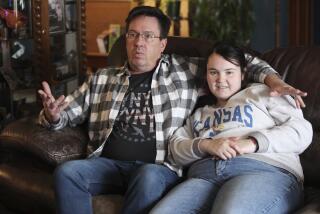Op-Ed: Rushing foster kids into quick adoptions isn’t always in their best interest

We may never know precisely why Jennifer Hart drove off a cliff in Northern California, killing herself, her partner and six children they had adopted out of the foster care system. We do know this culminated many years in which the children suffered severe abuse and neglect — and that despite investigations in multiple states, no child welfare agency intervened.
This tragedy could be written off as an isolated incident to be mourned. But the story also reflects the dangers of our foster care system’s obsession with adoption. The system sprints towards finalizing an adoption, then presumes success, hoists its trophy and takes its victory lap.
Every year, approximately 50,000 children in foster care are adopted after it’s been determined that they cannot go home. A 1997 federal law called the Adoption and Safe Families Act forces states to push for quick adoption, regardless of whether another arrangement may make more sense. For instance, permanent guardianship with a relative or foster parent or subsidized custody might be viable options for providing children with stable homes. But under this federal law, those options can be considered only after a state child welfare agency has definitively ruled out the possibility of an adoption.
The federal government enforces this in two ways. First, it can deprive states of millions of dollars in federal child welfare funding. Second, it can award performance bonuses to state child welfare agencies based on the number of adoptions they finalize, and how quickly they do so. Talk to child welfare professionals and they will describe the immense pressures they face to get children in foster care adopted.
Certainly, adoption is a good outcome for some children in foster care. Yet, we know too little to conclude that adoptions make sense for all of them. A child may want to have a continuing relationship a birth parent, even if that parent cannot care for them. Others may need ongoing support from state agencies, such as therapy, tutoring or specialized medical care, to address serious emotional or behavioral needs.
Adoption is a good outcome for some children in foster care. Yet, we know too little to conclude that adoptions make sense for all of them.
The U.S. has done little research to support this adoption-over-all approach. For example, we don’t know how frequently children reenter foster care after being taken away from adoptive parents, nor how often such families are investigated over suspected abuse or neglect. This type of information is well within the grasp of state child welfare agencies, but the federal government doesn’t require them to report it.
Though we know these things happen, no national study has ever identified the number of adoptions from foster care that fall apart, nor the number of adoptive parents who, unable to manage their children’s behaviors, place children in informal arrangements in other homes. (There have been small, local studies, but they vary widely in their estimates.) The Department of Health and Human Services simply concedes that it can’t figure it out because after an adoption is finalized, records are closed and names or Social Social Security numbers may be changed. In other words, a family’s privacy rights after an adoption is preventing our foster care system from knowing whether these arrangements actually work.
And yet advocates who represent families in the child welfare system can share countless stories of adopted children who later reentered foster care. For example, a former client of mine was adopted out of the Texas foster care system by a family in Michigan. Just months later, her adoptive father claimed that the adoption agency lied about the girl’s mental health issues, decided he couldn’t control her poor behavior, and handed her over to another family who promised that they could take care of her. Instead, she was physically and sexually tortured, as were other children in the home. Years later, the child welfare system intervened and placed her back in foster care.
Like the Hart children, my client’s story will never be captured by federal data and the foster care system won’t learn from her experience. Rather, the prevailing narrative will continue to equate adoption with success.
If the Hart tragedy offers us a lesson, it is that the federal government must reexamine the pressure it puts on states to get children in foster care adopted quickly. The Department of Health and Human Services could start by requiring state child welfare agencies to annually report how many child protective services investigations involve adoptive parents. It should also fund comprehensive studies into the number of foster care adoptions that are dissolved or disrupted.
Unless such research proves that adoption truly is best for all kids in foster care, federal law shouldn’t give states a financial bounty to pursue adoptions, nor should it force child welfare agencies to rule out adoptions before pursuing other options.
Would these changes have saved the Hart children? Probably not. But perhaps in the wake of their deaths, our foster care system can begin to exercise restraint and craft custody solutions that serve each unique child in its care.
Vivek S. Sankaran is a clinical professor of law at the University of Michigan.
Follow the Opinion section on Twitter @latimesopinionand Facebook
More to Read
A cure for the common opinion
Get thought-provoking perspectives with our weekly newsletter.
You may occasionally receive promotional content from the Los Angeles Times.






